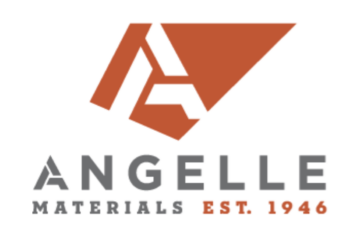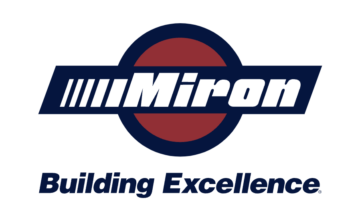radar—a nondestructive testing method for locating metal embedments, voids beneath pavements, or determining thickness of members; interface between materials with different dielectric properties results in reflection of a portion of incident electromagnetic pulse.
radiography—a nondestructive testing method for locating reinforcing and prestressing steel, conduits, pipes, voids, and honeycomb; the intensity of high-energy electromagnetic radiation which passes through a member is recorded on photographic film.
raft foundation—see foundation, raft.
rail-steel reinforcement—see reinforcement, rail-steel.
rake classifier—machine for separating coarse and fine particles of granular material temporarily suspended in water; the coarse particles settle to the bottom of a vessel and are scraped up an incline by a set of blades, the fine particles remaining in suspension to be carried over the edge of the classifier.
raker—a sloping brace for a shore head.
raked joint—see joint, raked.
raker pile—see pile, batter (preferred term).
raking pile—see pile, batter (preferred term).
ramming—a form of heavy tamping of concrete, grout, or the like by means of a blunt tool forcibly applied. (See also pack, dry; punning; and tamping.)
random ashlar—see masonry, ashlar (preferred term).
ranger—see wale (preferred term).
rapid chloride test—a method for on-site determinations of acid-soluble and water-soluble chloride ion contents of concrete powder samples with proprietary chloride extraction liquids and calibrated instrument probes.
ratio, A/F—the molar or mass ratio of aluminum oxide (Al2O3) to iron oxide (Fe2O3), as in portland cement.
ratio, aggregate-cement—the ratio of cement to total aggregate, either by mass or volume.
ratio, Poisson’s—the absolute value of the ratio of transverse (lateral) strain to the corresponding axial (longitudinal) strain resulting from uniformly distributed axial stress below the proportional limit of the material; the value will average approximately 0.2 for concrete and 0.25 for most metals.
raw mix—blend of raw materials, ground to desired fineness, correctly proportioned, and blended ready for burning; such as that used in the manufacture of cement clinker.
Rayleigh wave—an ultrasonic surface wave in which the particle motion is elliptical and effective penetration is approximately one wavelength.
reactant—a material that reacts chemically with the base component of a grout system.
reaction—
reaction, alkali-aggregate—chemical reaction in either mortar or concrete between alkalies (sodium and potassium) from portland cement or other sources and certain constituents of some aggregates; under certain conditions, deleterious expansion of concrete or mortar may result.
reaction, alkali-carbonate rock—the reaction between the alkalies (sodium and potassium) in portland cement and certain carbonate rocks, particularly calcitic dolomite and dolomitic limestones, present in some aggregates; the products of the reaction may cause abnormal expansion and cracking of concrete in service.
reaction, alkali-silica—the reaction between the alkalies (sodium and potassium) in portland cement and certain siliceous rocks or minerals, such as opaline chert, strained quartz, and acidic volcanic glass, present in some aggregates; the products of the reaction may cause abnormal expansion and cracking of concrete in service.
reaction, endothermic—a chemical reaction that occurs with the absorption of heat.
reaction, exothermic—a chemical reaction that occurs with the evolution of heat.
reaction, pozzolanic—see pozzolan.
reaction, subgrade—see contact pressure and coefficient of subgrade reaction.
reactive aggregate—see aggregate, reactive.
reactive silica material—several types of materials that react at high temperatures with portland cement or lime during autoclaving, includes pulverized silica, natural pozzolan, and fly ash.
reactivity (of aggregate), alkali—susceptibility of aggregate to alkali-aggregate reaction.
ready-mixed concrete—see concrete, ready-mixed.
rebar—colloquial term for reinforcing bar. (See also reinforcement.)
rebound—aggregate and cement, or wet shotcrete, that bounces away from the surface against which shotcrete is being projected.
rebound hammer—see hammer, rebound.
recycled concrete—see concrete, recycled.
reflective cracking—see cracking, reflective.
refusal—point in a grouting process when the resistance of the formation is equal to the pressure developed by the injection pump so that grout flow ceases.
refractories—materials, usually nonmetallic, used to withstand high temperatures.
refractoriness—in refractories, the property of being resistant to softening or deformation at high temperatures.
refractory—resistant to high temperatures.
refractory, castable—a packaged, dry mixture of hydraulic cement, generally calcium-aluminate cement, and specially selected and proportioned refractory aggregates that, when mixed with water, will produce refractory concrete or mortar.
refractory, neutral—a refractory that is resistant to chemical attack by either acidic or basic substances.
refractory aggregate—see aggregate, refractory.
refractory concrete—see concrete, refractory.
refractory-insulating concrete—see concrete, refractory-insulating.
reglet—a groove in a wall to receive flashing.
regulated-set cement—see cement, regulated-set.
rehabilitation—the process of repairing or modifying a structure to a desired useful condition. (See also preservation; repair; and restoration.)
reinforced concrete—see concrete, reinforced.
reinforced masonry—see masonry, reinforced.
reinforcement—(1) bars, wires, strands, fibers, or other slender members which are embedded in concrete primarily to improve tensile strength; (2) fibers and fillers that improve the physical strength of coating systems.
reinforcement, auxiliary—in a prestressed member, any reinforcement in addition to that participating in the prestressing function.
reinforcement, axle-steel—either plain or deformed reinforcing bars rolled from axle steel.
reinforcement bar—see reinforcement.
reinforcement, cold-drawn wire—steel wire made from rods that have been hot rolled from billets colddrawn through a die; for concrete reinforcement of a diameter not less than 0.080 in. (2 mm) nor greater than 0.625 in. (16 mm).
reinforcement, cold-worked steel—steel bars or wires that have been rolled, twisted, or drawn at normal ambient temperatures.
reinforcement, compression—reinforcement designed to carry compressive stresses. (See also stress.)
reinforcement, corner—metal reinforcement for plaster at reentrant corners to provide continuity between two intersecting planes; or concrete reinforcement used at wall intersections or near corners of square or rectangular openings in walls, slabs, or beams.
reinforcement, crack-control—reinforcement in concrete construction designed to minimize opening of cracks, often effective in limiting them to uniformly distributed small cracks.
reinforcement, curtain—a mat of orthogonal reinforcing steel in a member such as a wall; known as a double curtain (of reinforcement) when a mat is at each face.
reinforcement, deformed—metal bars, wire, or fabric with a manufactured pattern of surface ridges that provide a locking anchorage with surrounding concrete.
reinforcement, distribution-bar—small diameter bars, usually at right angles to the main reinforcement, intended to spread a concentrated load on a slab and to prevent cracking.
reinforcement, dowel-bar—see dowel.
reinforcement, edge-bar—tension steel sometimes used to strengthen otherwise inadequate edges in a slab without resorting to edge thickening.
reinforcement, expanded-metal fabric—see lath, expanded-metal.
reinforcement, four-way—a system of reinforcement in flat-slab construction comprising bands of bars parallel to two adjacent edges and also to both diagonals of a rectangular slab.
reinforcement, heavy-edge—wire-fabric reinforcement for highway pavement slabs having one to four edge wires heavier than the other longitudinal wires.
reinforcement, helical—steel reinforcement of hot-rolled bar or cold-drawn wire fabricated into a helix (more commonly known as spiral reinforcement).
reinforcement, high-strength—see steel, high-strength.
reinforcement, hoop—a one-piece closed tie or continuously wound tie not less than No. 3 in size, the ends of which have a standard 135 degree bend with a ten-bar diameter extension, that encloses the longitudinal reinforcement.
reinforcement, lateral—transverse reinforcement, usually applied to ties, hoops, and spirals in columns or column-like members.
reinforcement, longitudinal—reinforcement parallel to the length of a concrete member or pavement.
reinforcement, mesh—see fabric, welded-wire and reinforcement, welded-wire fabric.
reinforcement, negative—steel reinforcement for negative moment.
reinforcement, nonprestressed—reinforcing steel, not subjected to either pretensioning or post-tensioning.
reinforcement, nonstructural—see reinforcement, temperature.
reinforcement, positive—reinforcement for positive moment.
reinforcement, rail-steel—reinforcing bars hot-rolled from standard T-section rails.
reinforcement, shear—reinforcement designed to resist shear or diagonal tension stresses. (See also dowel.)
reinforcement, shrinkage—reinforcement designed to resist shrinkage stresses in concrete.
reinforcement, spiral—continuously wound reinforcement in the form of a cylindrical helix. (See also reinforcement, helical.)
reinforcement, temperature—reinforcement designed to carry stresses resulting from temperature changes; also the minimum reinforcement for areas of members that are not subjected to primary stresses or necessarily to temperature stresses.
reinforcement, tension—reinforcement designed to carry tensile stresses such as those in the bottom of a simple beam.
reinforcement, transverse—reinforcement at right angles to the longitudinal reinforcement.
reinforcement, twin-twisted bar—two bars of the same nominal diameter twisted together.
reinforcement, two-way—reinforcement arranged in bands of bars at right angles to each other.
reinforcement, web—reinforcement placed in a concrete member to resist shear and diagonal tension.
reinforcement, welded—reinforcement joined together by welding.
reinforcement, welded-wire fabric—welded-wire fabric in either sheets or rolls, used to reinforce concrete.
reinforcement, woven-wire—see fabric, welded-wire (preferred term).
reinforcement continuity—see continuity, reinforcement.
reinforcement displacement—movement of reinforcing steel from its specified position in the forms.
reinforcement ratio—ratio of the effective area of the reinforcement to the effective area of the concrete at any section of a structural member. (See also percentage of reinforcement.)
relative humidity—the ratio of the quantity of water vapor in the air to the maximum amount the air would hold at the same temperature, expressed as a percentage.
release agent—see agent, release.
release, partial—release into a prestressed-concrete member of a portion of the total prestress initially held wholly in the prestressed reinforcement.
remoldability—the readiness with which freshly mixed concrete responds to a remolding effort such as jigging or vibration, causing it to reshape its mass around reinforcement and to conform to the shape of the form. (See also flow.)
remolding test—see test, remoldability.
render—to apply a coat of mortar by a trowel or float.
repair—to replace or correct deteriorated, damaged, or faulty materials, components, or elements of a structure. (See also preservation; rehabilitation; and restoration.)
repair, full-depth—removal and replacement of damaged or deteriorated concrete that constitutes the full depth of a member or element.
repair, nonstructural—protective repair that is not intended to affect the structural capacity of a member.
repair, partial-depth—removal and replacement of damaged or deteriorated near-surface concrete that constitutes only a portion of the depth of a member or element.
repair, structural—repair that restores or enhances the structural capacity of a member.
repair process––the complete process of evaluating an existing structure, the design and implementation of stabilization measures and repairs; the repair process is complete when the use of repaired structure is transferred to the Owner and/or the repair contract terms are completed.
repair systems—the materials and techniques used for repair.
repeatability—variability among replicate test results obtained on the same material within a single laboratory by one operator; a quantity that will be exceeded in only about 5% of the repetitions by the difference, taken in absolute value, of two randomly selected test results obtained in the same laboratory on a given material; in use of the term, variable factors should be specified.
repost—see reshoring.
reproducibility—variability among replicate test results obtained on the same material in different laboratories; a quantity that will be exceeded in only approximately 5% of the repetitions by the difference, taken in absolute value, of two single test results made on the same material in two different, randomly selected laboratories; in use of the term, variable factors should be specified.
required strength—see strength, required.
resetting (of forms)—setting of forms separately for each successive lift of a wall to avoid offsets at construction joints.
reshoring—the construction operation in which the original shoring or posting is removed and replaced in such a manner as to avoid deflection of the shored element or damage to partially cured concrete.
residual deformation—see creep, nonrecoverable.
resilience—the work done per unit volume of a material in producing strain.
resin—a natural or synthetic, solid or semisolid, organic material of indefinite and often high molecular weight having a tendency to flow under stress; usually has a softening or melting range, and usually fractures conchoidally.
resin, acrylic—one of a group of thermoplastic resins formed by polymerizing the esters or amides in acrylic acid used to make polymer-cement and polymer mortars and concretes; also used in concrete construction as a bonding agent, surface sealer, or an integral concrete component.
resin, epoxy—a class of organic chemical bonding systems used in the preparation of special coatings for concrete, as adhesives for injection of cracked concrete, or as binders in epoxy-resin mortars, concretes, and fiber-reinforced polymer composites.
resin, furan—a thermosetting catalyzed condensation reaction product from furfuryl alcohol, furfural or combination thereof.
resin, methacrylate—one of a group of resins formed by polymerizing the esters or amides of acrylic acids.
resin, phenolic—a class of synthetic, oil-soluble resins (plastics) produced as condensation products of phenol, substituted phenols and formaldehyde, or some similar aldehyde that may be used in paints for concrete.
resin, polyester—one of a large group of synthetic resins, mainly produced by reaction of dibasic acids with dihydroxy alcohols; commonly prepared for application by mixing with a vinyl-group monomer and free-radical catalysts at ambient temperatures and used as binders for resin mortars and concretes, fiber laminates (mainly glass), adhesives, and the like; commonly referred to as unsaturated polyester.
resin, polystyrene—synthetic resins, varying from colorless to yellow, formed by the polymerization of styrene on heating with or without catalysts, that may be used in paints for concrete, or for making sculptured molds, or as insulation.
resin, silicone—a resin, characterized by water-repellent properties, in which the main polymer chain consists of alternating silicon and oxygen atoms, with carbon-containing side groups; silicones may be used in caulking or coating compounds or as admixtures for concrete.
resin, urea—a synthetic resin made from urea and an aldehyde.
resin, urethane—a class of resins obtained by the reaction of diisocyanates with organic compounds containing two or more active hydrogen atoms to form polymers having free isocyanate groups. Under the influence of heat or catalysts, the latter react with each other, with water, glycols, diamines, etc., to form a thermosetting material.
resin, vinyl ester—a thermosetting reaction product of epoxy resin with a polymerizable unsaturated acid, usually methacrylic acid, that is then diluted with a reactive monomer, usually styrene.
resin concrete—see concrete, polymer (preferred term).
resin mortar—see concrete, polymer.
resins, epoxy—a class of organic chemical bonding systems used in the preparation of special coatings or adhesives for concrete or as binders in epoxy-resin mortars and concretes.
resistance refractory aggregate—see aggregate, refractory.
resistance, abrasion—ability of a surface to resist being worn away by rubbing and friction.
resistance, fire—the property of a material or assembly to withstand fire or give protection from it; as applied to elements of buildings, it is characterized by the ability to confine a fire or, when exposed to fire, to continue to perform a given structural function, or both.
resistance, penetration—the resistance, usually expressed in lb/in.2 (psi) or megapascals (MPa), of either mortar or cement paste to penetration by a plunger or needle under standard conditions, such as to determine time of setting.
resistance, skid—a measure of the frictional characteristics of a surface.
resistance, sulfate—ability of concrete or mortar to withstand sulfate attack. (See also sulfate attack.)
resistance, thermal—the reciprocal of thermal conductance expressed by the symbol R.
restoration—the process of re-establishing the materials, form, and appearance of a structure to those of a particular era of the structure. (See also preservation; rehabilitation; and repair.)
restrained shrinkage test—test method (such as ASTM C1581) that attempts to simulate the complex interaction between load, strength gain, shrinkage, modulus of elasticity, creep, and other factors that govern the cracking potential of a restrained repair material.
restraint (of concrete)—restriction of free movement of fresh or hardened concrete following completion of placing in formwork or molds or within an otherwise confined space; restraint can be internal or external and may act in one or more directions.
retardation—reduction in the rate of either hardening, setting, or both, that is, an increase in the time required to reach time of initial and final setting or to develop early strength of fresh concrete, mortar, or grout. (See also retarder.)
retarder—an admixture that delays the setting of cement paste and mixtures, such as mortar or concrete, containing cement.(See also admixture, retarding).
retarder, surface—a retarder applied to the contact surface of a form or to the surface of newly placed concrete to delay setting of the cement, to facilitate construction joint cleanup, or to facilitate production of exposed-aggregate finish.
retarding admixture—see admixture, retarding.
retemper—to add water and remix a cementitious mixture to restore workability to a condition in which the mixture is placeable or usable. (See also temper.)
reveal (n.)—the vertical surface forming the side of an opening in a wall, as for a window or door; depth of exposure of aggregate in an exposed aggregate finish. (See also exposed-aggregate finish.)
revibration—one or more applications of vibration to fresh concrete after completion of placing and initial consolidation but preceding initial setting of the concrete.
revolving-blade (or paddle) mixer—see mixer, open-top.
rheology—the science dealing with flow of materials, including studies of deformation of hardened concrete, the handling and placing of freshly mixed concrete, and the behavior of slurries, pastes, and the like.
rib—one of a number of parallel structural members backing sheathing; the portion of a T-beam which projects below the slab; in deformed reinforcing bars, the deformations or the longitudinal parting ridge.
ribbed panel—see panel, ribbed.
ribbed slab—see panel, ribbed.
ribbon—a narrow strip of wood or other material used in formwork.
ribbon loading—see loading, ribbon.
rich concrete—see concrete, rich.
rich mixture—a concrete mixture containing a high proportion of cement.
rider cap—see cap, pile.
rigid frame—see frame, rigid.
rigid pavement—see pavement, rigid.
rigidity, flexural—a measure of stiffness of a member, indicated by the product of modulus of elasticity and moment of inertia divided by the length of the member.
ring, air—perforated manifold in nozzle of wet-mix shotcrete equipment through which high pressure air is introduced into the material flow.
ring, proving—a device for calibrating load indicators of testing machines, consisting of a calibrated elastic ring and a mechanism or device for indicating the magnitude of deformation under load.
rock pocket—a porous, mortar-deficient portion of hardened concrete consisting primarily of coarse aggregate and open voids; caused by leakage of mortar from the form, separation (segregation) during placement, or insufficient consolidation. (See also honeycomb.)
rod—sharp-edged cutting screed used to trim shotcrete to forms or ground wires. (See also screed.)
rod, dowel—see dowel (preferred term).
rod, pencil—plain metal rod of about 1/4 in. (6 mm) diameter.
rod, tamping—a straight steel rod of circular cross-section and having one or both ends rounded to a hemispherical tip.
rod, tie—see tie, form and tieback.
rodability—the susceptibility of fresh concrete or mortar to consolidation by means of a tamping rod.
rod buster (colloquial)—one who installs reinforcement for concrete.
rodding—consolidating concrete with a tamping rod. (See also rod; rodability; and tamping.)
rodding, dry—in measurement of the mass per unit volume of coarse aggregates, the process of consolidating dry material in a calibrated container by rodding under standardized conditions.
rod mill—see mill, rod.
roller-compacted concrete—see concrete, roller-compacted.
roller compaction—use of a vibratory, or other type roller, to compact concrete.
rolling—an uneven, wavy, textured surface at the outer edge of a spray pattern resulting from the application of shotcrete at angles less than 90 degrees to the receiving surface; the use of heavy metal or stone rollers on terrazzo topping to extract excess matrix.
Roman cement—see cement, Roman.
roof, barrel-vault—a thin concrete roof in the form of a part of a cylinder.
roof insulation—see insulation, roof.
room, fog—see moist room (preferred term).
Rosiwal method—see linear-traverse method.
rotary drilling—a process for drilling a hole with a rotating drill bit under constant pressure. (See also percussion drilling.)
rotary float (also called power float)—see float, rotary.
rotary kiln—see kiln, rotary.
rough grind—the initial operation in which coarse abrasives are used to reduce the projecting stone chips in hardened terrazzo down to a level surface.
roughness—a measure of the texture of a surface; quantified by the vertical deviations of a prepared concrete surface from an ideal plane. If these deviations are large, the surface is rough; if they are small the surface is smooth.
rout—to deepen and widen a crack to prepare it for patching or sealing.
roving—a collection of bundles of continuous glass fiber filaments, either as untwisted strands or as twisted yarns.
rub brick—see brick, rubbing (preferred term).
rubbing brick—see brick, rubbing.
rubbed finish—see finish, rubbed.
rubber set—see set, false (preferred term).
rubble—rough stones of irregular shape and size, broken from larger masses by geological processes or by quarrying; concrete reduced to irregular fragments, as by demolition or natural catastrophe.
rubble concrete—see concrete, rubble.
runs—sagging and curtaining of a coating usually caused by improper mixing or poor application techniques.
runway—decking over the area of concrete placement, usually of movable panels and supports, on which buggies of concrete travel to points of placement.
rupture modulus—see modulus of rupture.
rupture strength—see modulus of rupture.
rust—a corrosion product consisting primarily of hydrated iron oxide.
rustic or washed finish—see finish, rustic or washed.
rustication—a strip of wood or other material attached to a form surface to produce a groove in the repair.
rustication strip—see strip, rustication.
rutting—the formation of depressions in a concrete surface caused by the excessive loading and abrasive wearing action of traffic.
R-value—see resistance, thermal.





